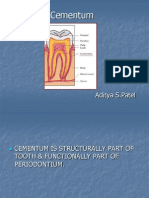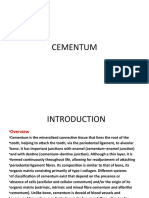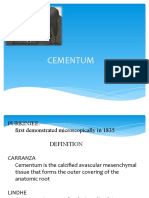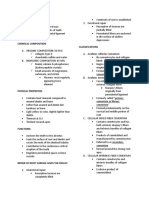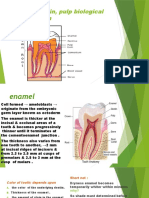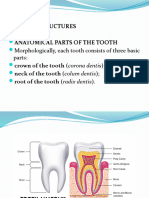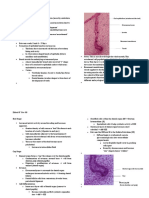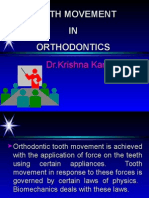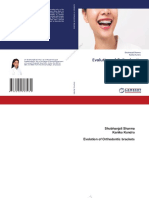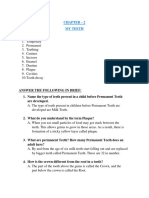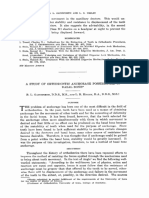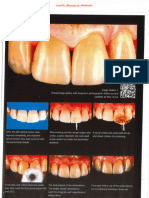Section Iii: A. Four Tissues of A Tooth
Section Iii: A. Four Tissues of A Tooth
Uploaded by
Yoshe Kartika SentosaCopyright:
Available Formats
Section Iii: A. Four Tissues of A Tooth
Section Iii: A. Four Tissues of A Tooth
Uploaded by
Yoshe Kartika SentosaOriginal Description:
Original Title
Copyright
Available Formats
Share this document
Did you find this document useful?
Is this content inappropriate?
Copyright:
Available Formats
Section Iii: A. Four Tissues of A Tooth
Section Iii: A. Four Tissues of A Tooth
Uploaded by
Yoshe Kartika SentosaCopyright:
Available Formats
Chapter 1 | Basic Terminology for Understanding Tooth Morphology 11
SECTION III TERMINOLOGY USED TO DESCRIBE THE PARTS OF A TOOTH
A. FOUR TISSUES OF A TOOTH of cementum is about 50%.) Cementum is about as
hard as bone but considerably softer than enamel.
The tooth is made up of four tissues: enamel, dentin,
It develops from the dental sac (mesoderm), and is
cementum, and pulp. The first three of these (enamel,
produced by cells called cementoblasts [se MEN toe
dentin, and cementum) are relatively hard since they
blasts].
contain considerable mineral content, especially cal-
The cementoenamel [se MEN toe ehn AM el] junc-
cium (so these tissues can also be described as calci-
tion (also called the CEJ) separates the enamel of the
fied). Only two of these tissues are normally visible in
crown from the cementum of the anatomic root. This
an intact extracted tooth: enamel and cementum. The
junction is also known as the cervical [SER vi kal] line,
other two tissues (dentin and pulp) are usually not vis-
denoting that it surrounds the neck or cervix [SER
ible on an intact tooth. Refer to Figure 1-6 while read-
viks] of the tooth.
ing about each tissue.
Dentin [DEN tin] is the hard yellowish tissue under-
Enamel [ee NAM el] is the white, protective external
lying the enamel and cementum, and makes up the
surface layer of the anatomic crown. It is highly cal-
major bulk of the inner portion of each tooth crown
cified or mineralized, and is the hardest substance in
and root. It extends from the pulp cavity in the center
the body. Its mineral content is 95% calcium hydroxy-
of the tooth outward to the inner surface of the enamel
apatite (which is calcified). The remaining substances
(on the crown) or cementum (on the root). Dentin is
include 5% water and enamel matrix. It develops from
not normally visible except on a dental radiograph,
the enamel organ (ectoderm) and is a product of spe-
or when the enamel or cementum have been worn
cialized epithelial cells called ameloblasts [ah MEL o
away, or cut away when preparing a tooth with a bur,
blasts].
or destroyed by decay. Mature dentin is composed of
Cementum [se MEN tum] is the dull yellow exter-
about 70% calcium hydroxyapatite, 18% organic mat-
nal layer of the tooth root. The cementum is very thin,
ter (collagen fibers), and 12% water, making it harder
especially next to the cervical line, similar in thickness
than cementum but softer and less brittle than enamel.
to a page in this text (only 50–100 mm thick where one
Dentin develops from the embryonic dental papilla
mm is one millionth of a meter). It is composed of 65%
(mesoderm). The cells that form dentin, called odon-
calcium hydroxyapatite (mineralized and calcified),
toblasts [o DON toe blasts], are located at the junction
35% organic matter (collagen fibers), and 12% water.
between pulp and dentin.
(Another author, Melfi, states that the mineral content
Apical foramen
Root canal
Anatomic Root
Cementum
Dentin
Cementodentinal
junction FIGURE 1-6.
A maxillary anterior
Pulp chamber
tooth sectioned longitudinally through
the middle to show the distribution of
Cementoenamel junction the tooth tissues and the shape of the
pulp cavity (made up of pulp chamber
Anatomic Crown
Enamel and root canal). On the right is a
close-up of the apical portion depicting
Dentinoenamel junction the usual expected constriction of the
root canal near the apical foramen. The
Lingual surface of crown layer of cementum covering the root of
an actual tooth is proportionately much
thinner than seen in these drawings.
12 Part 1 | Comparative Tooth Anatomy
Dentinoenamel junction
FIGURE 1-7.
Radiographs (x-rays) showing
tooth crowns covered with enamel, and the
Enamel
tooth roots embedded within the alveolar
Dentin bone. You can distinguish the whiter outer
enamel shape from the darker inner dentin,
Pulp and the darkest pulp chamber in the middle of
Periodontal ligament the tooth. The very thin, dark periodontal
(dark line) ligament can also be seen between the root and
Alveolar bone the bone, but the cementum cannot be seen.
The dentinoenamel [DEN tin o ehn AM el] junction • Defensive or protective: Pulp responds to injury
is the inner surface of the enamel cap where enamel or decay by forming reparative dentin (by the
joins dentin. This junction can be best seen on a radio- odontoblasts).
graph (Fig. 1-7). The cementodentinal [se MEN toe
DEN tin al] (or dentinocemental) junction is the inner
surface of cementum where cementum joins dentin.
B. ANATOMIC VERSUS CLINICAL
Cementum is so thin that it is difficult to identify this CROWN AND ROOT
junction on a radiograph. 1. ANATOMIC CROWN AND ROOT
Pulp is the soft (not calcified or mineralized) tissue DEFINITION
in the cavity or space in the center of the crown and
root called the pulp cavity. The pulp cavity has a coro- The anatomic crown is that part of the tooth (in the
nal portion (pulp chamber) and a root portion (pulp mouth or handheld) normally covered by an enamel
canal or root canal). The pulp cavity is surrounded layer, and the anatomic root is the part of a tooth cov-
by dentin, except at a hole (or holes) near the root tip ered by cementum (Fig. 1-6). A cervical line (or cemen-
(apex) called an apical [APE i kal] foramen [fo RAY toenamel junction) separates the anatomic crown from
men] (plural foramina [fo RAM i na]). Nerves and the anatomic root. This relationship does not change
blood vessels enter the pulp through apical foramina. over a patient’s lifetime.
Like dentin, the pulp is normally not visible, except on a
dental radiograph (x-ray) or sectioned tooth (Fig. 1-7). 2. CLINICAL CROWN AND ROOT (ONLY
It develops from the dental papilla (mesoderm). Pulp is APPLIES WHEN THE TOOTH IS IN THE
soft connective tissue containing a rich supply of blood MOUTH AND AT LEAST PARTIALLY
vessels and nerves. Functions of the dental pulp are as ERUPTED)
follows:
The clinical crown refers specifically to the amount
• Formative: Dentin-producing cells (odontoblasts) of tooth visible in the oral cavity, and the clinical root
produce dentin throughout the life of a tooth. This is refers to the amount of tooth that is not visible since it
called secondary dentin. is covered with gingiva (gum tissue). Clinically, the gin-
• Sensory: Nerve endings relay the sense of pain caused gival margin in a 25-year-old patient with healthy gin-
from heat, cold, drilling, sweet foods, decay, trauma, giva approximately follows the curvature of the cervical
or infection to the brain, so we feel it. However, the line, and under these conditions, the clinical crown is
nerve fibers in a dental pulp are unable to distin- essentially the same as the anatomic crown. However,
guish the cause of the pain. the gingival margin is not always at the level of the cer-
• Nutritive: Blood vessels transport nutrients from vical line because of the eruption process early in life or
the bloodstream to cells of the pulp and the odon- due to recession of the gingiva later in life. For example,
toblasts that produce dentin. (Surprisingly, blood in the gingiva on a partially erupted tooth of a 10-year-old
the tooth pulp had passed through the heart only covers much of the enamel of the anatomic crown of
6 seconds previously.) the tooth, resulting in a clinical crown (exposed in the
You might also like
- Jörg A. Auer Craniomaxillofacial Disorders (Equine Surgery (Fourth Edition) )Document27 pagesJörg A. Auer Craniomaxillofacial Disorders (Equine Surgery (Fourth Edition) )Ana Carolina MartinsNo ratings yet
- CementumDocument47 pagesCementumpratikl12345No ratings yet
- CEMENTUM & CementogenesisDocument41 pagesCEMENTUM & CementogenesisMohammed hisham khan100% (5)
- Nature Science3 SyllabusDocument18 pagesNature Science3 SyllabusBakó Judit100% (1)
- Clinical Significance OF Dental Anatomy, Histology, Physiology, and OcclusionDocument77 pagesClinical Significance OF Dental Anatomy, Histology, Physiology, and OcclusionDiana ConcepcionNo ratings yet
- NBDE Dental Anatomy T-Comp: Study Online atDocument5 pagesNBDE Dental Anatomy T-Comp: Study Online atSchat ZiNo ratings yet
- CementumDocument78 pagesCementumShuba Prasad100% (1)
- An Overview of Oral TissuesDocument4 pagesAn Overview of Oral TissuesRenukaChauveNo ratings yet
- 6 CementumDocument81 pages6 CementumYousef ZaiterNo ratings yet
- Cementum, Abnormalities Of,: Reversal Lines Cementicle HypercementosisDocument4 pagesCementum, Abnormalities Of,: Reversal Lines Cementicle HypercementosisJack SuquitaNo ratings yet
- CEMENTUM SeminarDocument63 pagesCEMENTUM SeminarviolaNo ratings yet
- Cement UmDocument8 pagesCement UmHannasa R JNo ratings yet
- Cementoenamel Junction An InsightDocument6 pagesCementoenamel Junction An InsightJessica ChenNo ratings yet
- Embryology & Histology of Cementum: DR - Kemer KDocument41 pagesEmbryology & Histology of Cementum: DR - Kemer KLintoNo ratings yet
- Perio 3Document6 pagesPerio 3Bea YmsnNo ratings yet
- Oh&e Midterm NotesDocument36 pagesOh&e Midterm NotesSHYRE COLEEN CATAYAONo ratings yet
- CEMENTUMDocument2 pagesCEMENTUMAlyssa LumaadNo ratings yet
- Cementum SolvedDocument14 pagesCementum Solvedsteam inventoryNo ratings yet
- Structure of Tooth 2014 ID TopicsDocument24 pagesStructure of Tooth 2014 ID TopicsIsdianaNo ratings yet
- CementumDocument18 pagesCementumBahia A RahmanNo ratings yet
- Enamel, Dentin, Pulp Biological ConsiderationDocument41 pagesEnamel, Dentin, Pulp Biological ConsiderationMohammad ANo ratings yet
- The Effects of High Rate Cementogenesis in Cellular CementumDocument14 pagesThe Effects of High Rate Cementogenesis in Cellular CementumoystylesNo ratings yet
- Ultrastructural Gigi U PraktikumDocument64 pagesUltrastructural Gigi U PraktikumfgrehNo ratings yet
- CementumDocument10 pagesCementumAshish BisaneNo ratings yet
- CementumDocument4 pagesCementumimsahoo85No ratings yet
- Odonto GenesisDocument3 pagesOdonto GenesisyashsodhaniNo ratings yet
- Morphology II - Lecture 1, Dental StructuresDocument22 pagesMorphology II - Lecture 1, Dental StructuresJoschiNo ratings yet
- Tmpyjlins - Chuong 1 Over ViewDocument54 pagesTmpyjlins - Chuong 1 Over ViewMinh Thu VũNo ratings yet
- Cementum: Dr. Raina Khanam Mds 1 Year Department of PeriodonticsDocument60 pagesCementum: Dr. Raina Khanam Mds 1 Year Department of PeriodonticsAtul KoundelNo ratings yet
- Structures of Teeth 4Document1 pageStructures of Teeth 4Tayyuba AslamNo ratings yet
- 5 - CementumDocument22 pages5 - CementumReda IsmaeelNo ratings yet
- Oral Histology SlidesDocument60 pagesOral Histology SlidesRan And SanNo ratings yet
- Cementum Part IDocument18 pagesCementum Part Isailajanekkanti03No ratings yet
- Tooth Dcevelopment 07Document71 pagesTooth Dcevelopment 07Daniel Vega AdauyNo ratings yet
- 2 - Human Dentition IntroDocument71 pages2 - Human Dentition IntroozyiamandsNo ratings yet
- Cementum & PDLDocument86 pagesCementum & PDLNikita SebastianNo ratings yet
- Dental Anatomy and OcclusionDocument53 pagesDental Anatomy and OcclusionIlinca LupuNo ratings yet
- Cement DR Ahmed Ezzat-1Document5 pagesCement DR Ahmed Ezzat-1Afaf MagedNo ratings yet
- CementumDocument32 pagesCementumkaminisingh918No ratings yet
- Seminar On Cementum: Shreya Das Intern Department of PeriodontiaDocument57 pagesSeminar On Cementum: Shreya Das Intern Department of Periodontiashreya dasNo ratings yet
- Cementum PDFDocument12 pagesCementum PDFHafra AminiNo ratings yet
- AmelogenesisDocument106 pagesAmelogenesisJohn QueenNo ratings yet
- Oral Histo Midterm Review PDFDocument17 pagesOral Histo Midterm Review PDFHãnëën TwalbehNo ratings yet
- Cementum in Health and DiseaseDocument51 pagesCementum in Health and Diseasemunnabjujji100% (1)
- Orban Chapter 1Document2 pagesOrban Chapter 1Shreya VyasNo ratings yet
- Tooth DevelopmentDocument20 pagesTooth DevelopmentArslan Jokhio0% (1)
- Structures of Teeth 1Document1 pageStructures of Teeth 1Tayyuba AslamNo ratings yet
- 1 Tooth DevelopmentDocument65 pages1 Tooth DevelopmentHabeeb AL-AbsiNo ratings yet
- Jenis Jenis Dentin - 98Document5 pagesJenis Jenis Dentin - 98Zaizafunil SyifaNo ratings yet
- CEMENTUMDocument80 pagesCEMENTUMReshmaa RajendranNo ratings yet
- FOB Tooth DevelopmentDocument4 pagesFOB Tooth Developmentchopped5No ratings yet
- Terminology Used To Describe The Tissues of A Tooth: DR - Yad Raouf BDS, Efb, MrcsedDocument20 pagesTerminology Used To Describe The Tissues of A Tooth: DR - Yad Raouf BDS, Efb, MrcsedRabarNo ratings yet
- Anatomy: Primary TeethDocument6 pagesAnatomy: Primary TeethJaisurya SharmaNo ratings yet
- Structure of Tooth m121Document13 pagesStructure of Tooth m121amirhossein vaeziNo ratings yet
- Dental CementumDocument35 pagesDental CementumSebastián BernalNo ratings yet
- Structure and Properties of Enamel and DentinDocument17 pagesStructure and Properties of Enamel and DentinFile SeffinaNo ratings yet
- 4 - The Periodontium (Mahmoud Bakr)Document128 pages4 - The Periodontium (Mahmoud Bakr)MobarobberNo ratings yet
- Cementum: Avisha AgrawalDocument109 pagesCementum: Avisha AgrawalpoojaNo ratings yet
- Orthodontically Induced Inflammatory Root ResorptionDocument15 pagesOrthodontically Induced Inflammatory Root ResorptionmutansNo ratings yet
- Physical Assessment Body Part Normal Findings Actual Findings Interpretation and Analysis NormalDocument24 pagesPhysical Assessment Body Part Normal Findings Actual Findings Interpretation and Analysis Normaljose santiagoNo ratings yet
- Restoration of Endodontically Treated Teeth: Answers To Important QuestionsDocument57 pagesRestoration of Endodontically Treated Teeth: Answers To Important QuestionsGermanLoopezzNo ratings yet
- Esthetic in Complete DentureDocument14 pagesEsthetic in Complete DentureNidhi KatochNo ratings yet
- The Damon Passive Self-LigatingDocument17 pagesThe Damon Passive Self-Ligatingrosis27100% (1)
- Dental Age Estimation in Belgian Children DemirjiaDocument4 pagesDental Age Estimation in Belgian Children Demirjiajoy parimalaNo ratings yet
- L15 Texture Profile AnalysisDocument40 pagesL15 Texture Profile AnalysisRachmat Wahyu Dwicahyo100% (1)
- Features of Informative TextDocument27 pagesFeatures of Informative TextNoel GuevarraNo ratings yet
- Oral Anatomy Lecture 2 Tooth and Its Supporting StructureDocument73 pagesOral Anatomy Lecture 2 Tooth and Its Supporting StructurePhoelise SalazarNo ratings yet
- Kobe Bolt and EngineeringDocument32 pagesKobe Bolt and EngineeringTh Nattapong100% (1)
- Restoration of Endodontically Treated TeethDocument7 pagesRestoration of Endodontically Treated TeethSuaeni Kurnia WirdaNo ratings yet
- NCMB 316 M1 Cu1Document23 pagesNCMB 316 M1 Cu1Maica Lectana100% (1)
- Tooth Movement in OrthodonticsDocument45 pagesTooth Movement in Orthodonticsarshabharata100% (3)
- Extraction of Primary Teeth in Children: An Observational StudyDocument6 pagesExtraction of Primary Teeth in Children: An Observational StudyhayiarNo ratings yet
- Erosion Abrasion Attrition and Abfrcation1Document82 pagesErosion Abrasion Attrition and Abfrcation1msodontoNo ratings yet
- Growth of The Face and Dental ArchesDocument48 pagesGrowth of The Face and Dental ArchesArmaghan JafarabadiNo ratings yet
- Dental Anatomy 1Document33 pagesDental Anatomy 1dehaa100% (1)
- Karen S INBDE Test Second Attempt PDFDocument9 pagesKaren S INBDE Test Second Attempt PDFMohammed NabeelNo ratings yet
- Evolution of Orthodontic BracketsDocument281 pagesEvolution of Orthodontic Bracketssajida khan100% (2)
- VITA 1511 VITA 1511E Prothetikleitfaden BA en V01 Screen enDocument150 pagesVITA 1511 VITA 1511E Prothetikleitfaden BA en V01 Screen enAstri Ggamjong Xiao LuNo ratings yet
- Canine Impaction Oral SurgeryDocument6 pagesCanine Impaction Oral SurgeryFourthMolar.comNo ratings yet
- Kwon 2018Document11 pagesKwon 2018fatimahNo ratings yet
- Ielts Academic Reading Practice Test 13 4ff0635013Document3 pagesIelts Academic Reading Practice Test 13 4ff0635013JohnNo ratings yet
- The IADC Roller Bit Classification SystemDocument18 pagesThe IADC Roller Bit Classification SystemDavid KlinkenbergNo ratings yet
- Grade 4 Science 2 TeethDocument5 pagesGrade 4 Science 2 Teethjain.radha.aggrNo ratings yet
- Gainsforth 1945Document12 pagesGainsforth 1945Víctor Adolfo Ravelo SalinasNo ratings yet
- Layers (2) Direct Composites-5Document30 pagesLayers (2) Direct Composites-5arangoanNo ratings yet
- 6-Year-Follo Up. 3 Steps Techniques. Francesca Valati-1 PDFDocument25 pages6-Year-Follo Up. 3 Steps Techniques. Francesca Valati-1 PDFAdriana CoronadoNo ratings yet


